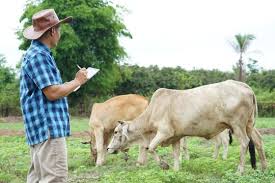The success in farm management requires the capacity and ability on the part of the farmer to make correct decisions. Decision-making on the part of the farm manager is one of the crucial functions.
The total system can be improved and streamlined through research and educational programs. In order to improve management ability, one needs a process model to know what one is trying to improve.
A farm manager can be anybody with a university degree or Higher National Diploma in Agricultural Economics, Farm Management, or General Agriculture in charge of overseeing a farm. In addition, he is expected to possess the following attributes:
i. A good farm manager must possess a scientific and analytical mind and must have the mental capacity to think through and solve a problem.
ii. He must be hardworking and dedicated.
iii. He must be ready to take useful advice from his fellow colleagues when taking some vital management decisions.
iv. He must have imagination, insight, and initiative necessary to gather new knowledge and the willingness and ability to learn.
v. An efficient farm manager must have the willingness and ability to accept responsibility and a reasonable degree of risk.
vi. A good farm manager must have the ability to take action and get things done.
vii. The acquisition of the attributes enunciated above requires not only the possession of entrepreneurial ability on the part of the manager but also some level of technical competence in agriculture.
Functions of the Farm Manager in Farm Management
Management is a decision-making process that coordinates the factors of production to produce the desired output. The four major functions of management include planning, organizing, directing, and controlling.
Read Also: Nine (9) Nutrient Requirements of Rabbits
Planning in Farm Management

Planning is a basic but complex management function combining financial, physical, and technical aspects for selecting and developing the best of the alternative ways of achieving stated objectives.
Planning itself is concerned with what needs to be done. Planning, therefore, is essentially decision-making since it means selecting courses of action, from amongst alternatives, either for the entire business or for any part of it.
Planning is the establishment of organizational goals and a strategy for accomplishing them. Plans made will usually be concerned with the short-, medium-, and long-term goals of the organization.
Setting up a goal as well as devising a workable strategy for attaining the goal are important attributes of good management. Once the goal and strategies have been set, the organizing function makes things proceed as planned.
Organizing in Farm Management
Organizing is therefore an operational function that depends heavily on the coordinated effort of an entire organization. Management directs the operations to achieve desired goals through innovation. Management seeks to obtain a high level of productivity from the employees through motivation and proper guidance by maintaining a high level of cooperation.
Controlling in Farm Management

The managerial function of control is the process by which action is adjusted to achieve business objectives. It is not merely the collection of information. All managers, but especially those entrusted with effecting plans, exercise control by taking action to return to course when events have not occurred as planned.
Put simply, managerial control means knowing where you are going, when you should be there, how to get there, where you are now, changing direction if you are off-course, and moving faster or slower if your timing is not as planned. Departures from the plan should be found soon enough to allow early, efficient correction at a reasonable cost.
Control is justified only if departures from the plan are corrected or the plan is redrawn. An effective control system requires the following steps:
i. The key areas to be controlled should be defined when the plan is made.
ii. Performance standards should be set for the key areas.
iii. Execute the plan and measure the results.
iv. Compare results with the pre-set standards.
v. Take corrective action.
In essence, the control function deals with the supervision of the achievement of goals and comparing actual results with those envisaged in the plans and the actual performance in past periods. The results are directly examined and related to the plans and performance standards established by other managerial functions.
Read Also: Principles of Feeding Rabbit and Feed Resources
Decision-Making in Farm Management

Decision-making is the activity of selecting from among possible alternatives, a future course of action. It is essentially, therefore, choosing between alternatives, even if the alternatives are to accept a proposed change or to continue as at present.
Managers are making decisions almost constantly, for if no decisions had to be made, there would be no need for managers. It has been said that decision-making is management, and managers are often judged by their ability to make decisions.
All managers, whatever their precise roles, are constantly involved in such decisions as how to use resources, determining production plans, and investment priorities.
Decision-making is the most important responsibility of a manager. These decisions form the life-wire of the farm business. A successful manager is one who has the skill to choose between alternatives fast. In doing so, he uses the problem-solving approach, which can be broken down into eight components.
A problem exists when “what is” differs from “what ought to be.” The problem must first be recognized by asking, “Does what exists differ from what ought to be?” The problem needs to be defined in operational terms once recognized.
Having defined the problem, the manager must observe facts about the problem and conceive ideas about its solution. Making relevant observations depends on the ability of the individuals. The farm manager must set objectives to gather relevant information and record information for future use.
At the analysis stage, the manager must relate the data available to the problem and objectives, develop alternative solutions, and analyze the problem. He can then uncover some new difficulties and readjust his solution. If further information is needed to solve the problem, he should go back and gather more information, thus providing a feedback loop between the various stages.
For example, he may, at the analysis stage, find he needs to redefine the problem to be able to solve it. He then goes back to the problem definition stage and subsequently gathers new relevant data. The best solution should be chosen, and appropriate action taken. The acceptance of responsibility is important because taking action involves some risk-bearing. The farm manager must be ready to bear the responsibility of his actions.
Do you have any questions, suggestions, or contributions? If so, please feel free to use the comment box below to share your thoughts. We also encourage you to kindly share this information with others who might benefit from it. Since we can’t reach everyone at once, we truly appreciate your help in spreading the word. Thank you so much for your support and for sharing!
Read Also: The Easiest Way to Fix Garbage Disposal Jam
Frequently Asked Questions
We will update this section soon.

